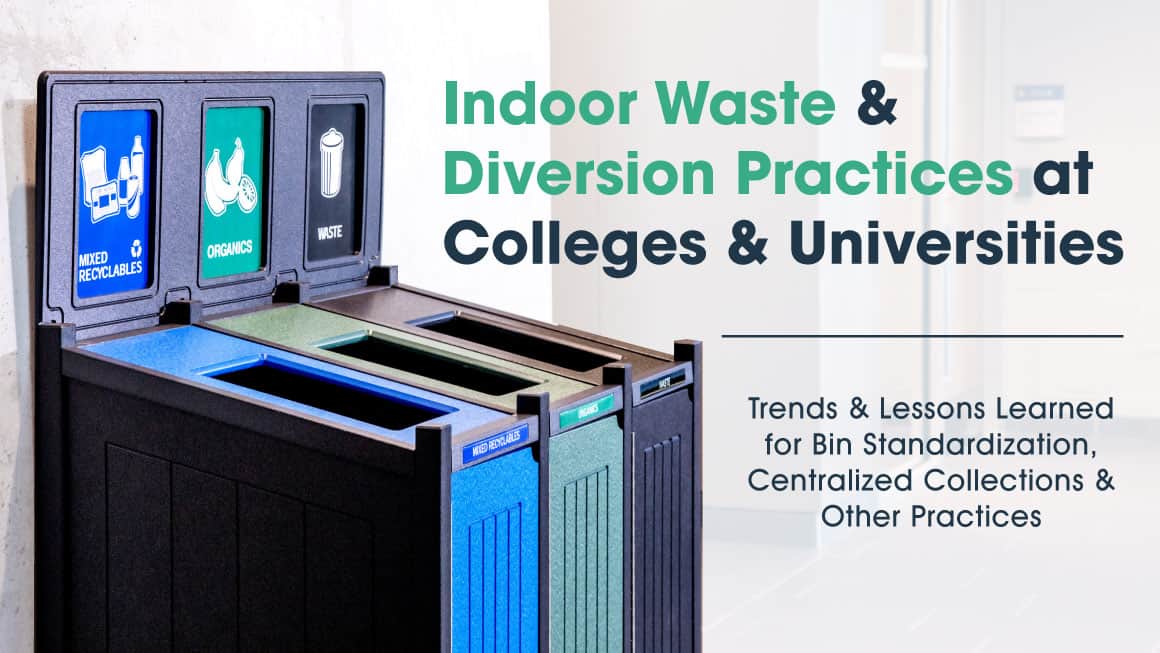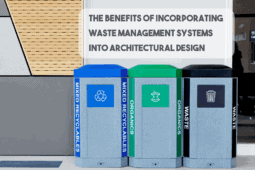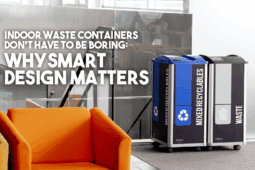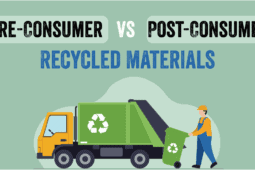
November 8, 2024 By Alec Cooley No Comments
New Report Shows Growing Embrace of Bin Standards and Centralized Collections
Hidden far outside the spectacle of NCAA gameday rivalries and academic rankings, higher education is changing the way it takes out the trash. This is the big takeaway from a new report, Indoor Waste & Diversion at Colleges and Universities, published by Busch Systems in collaboration with the Association for the Advancement of Sustainability in Higher Education (AASHE), College & University Recycling Coalition (CURC), Zero Waste Campus Council, National Wildlife Federation and Campus Race to Zero Waste.
The report, which summarizes the results of a survey of campus sustainability managers conducted earlier this spring, shows that a growing number of schools are embracing practices like removing waste bins from classrooms and shifting responsibility from custodians to staff and faculty to empty personal waste from office workstations. And the changes are making a difference, improving waste diversion and reducing operational costs.
Click here to download the full report
Proven to Work, but Challenging to Implement
The survey project was motivated by several observations about campus diversion programs. Recycling and other diversion efforts tend to plateau over time. Without a strategic plan to guide planning decisions, schools often accumulate generations of mismatched bins and rely on modified collection arrangements originally designed to handle everything as trash. The result is an hoc recycling system that confuses and, in many cases, disincentivizes people from sorting their waste properly. But just like energy management and other building systems, waste collection can be optimized to deliver better results by standardizing the design of public-facing collection bins and centralized collection arrangements that put trash and diversion on equal footing. But implementing these changes can be expensive in the case of standardized bins, and often face initial resistance from office workers and other stakeholders accustomed to a concierge-style service that makes waste disappear from virtually anywhere it gets generated. Sustainability and facilities managers interested to modernize their collection system often face skepticism from upper administrators. Before deciding trash collection is a battle they want to pick with tenured professors, they want to see evidence these changes are established practices and that their peer institutions have adopted them with success. But while program managers may be aware of other schools implementing these practices, there’s little published information about bin standardization or centralized collections they can refer decision makers to. This report is intended to help fill this gap.
Who’s Represented in The Results
The survey involved between 15 and 20 questions focused on documenting three types of findings: 1) how widely adopted are these best practices, 2) have they led to observable impacts, and 3) what lessons have been learned about how to implement them. The online form was distributed to a wide network of 1,000+ campus program managers. The results draw on the responses of 170 colleges and universities of all sizes and shapes from across the US and Canada. Understanding the responses wouldn’t exceed more than a small fraction of the 4,000+ higher ed institutions, special effort was made to recruit from a subset of larger US-based 4-year schools (over 10,000 FTE) that we where confident of attracting in significant numbers. In the end, the survey was completed by 93 out of the 285 such institutions, or roughly one third. While this sample didn’t ultimately lead to statistically representative findings, it does give us a clear window into what’s happening with this subset that includes many of the highest profile institutions in the US. For this reason, the report focuses the results about best practice adoption trends to just these large American 4-year schools. And because their relevance is less tied to the type of institution, stats about the actual impact and implementation strategies of these practices draw from any institutions within the overall sample of 170 school that’ve implemented them.
Report Highlights
I’ll dive into the results with more detail in separate blogs in the coming weeks, but a few noteworthy results stand out to me.
- There’s a clear trend toward Bin Standards. If you go back 20 or so years most campuses had an ad hoc, uncoordinated network of waste bins that reflected the separate style and branding decisions of different staff members over time. Though many survey participants are still phasing them in as budgets allow for new bin purchases, the results show significant movement toward a uniform standard with 66% of the large 4-year subset having formally adopted guidelines for indoor bin designs, and 72% for uniform labels and signage.
- Recycling is blue. Compost is green. To the extent that schools in past decades distinguished waste streams with consistent color schemes, green was commonly assigned to recycling and many others relied on their school colors or other factors unrelated to waste diversion. Whether part of official guidelines or just an informal default, 85% of the survey subset has now consolidated around blue for recycling. And where brown or yellow were often used for compost even a decade ago, 81% now use green.
- Centralized Collections are impactful. The survey asked those participants that had discontinued deskside custodial waste service and / or removed bins from classrooms whether the changes had an impact to increase diversion, lower contamination or reduce labor or direct costs. In each case a majority responded yes. The most clearcut benefit was to reduce custodial labor, with 86% agreeing in the case of deskside service and 93% agreeing with classroom bin removal.
- Successful schools embrace best practices. Using campus diversion rates reported by participants, we looked to see if there was a relationship between the adoption of specific practices and a school’s overall performance. For our sample of large 4-year American schools at least, the answer is a clear yes. Schools with diversion rates over 40% are more likely to have adopted bin standards and to include food waste with their central bin stations in academic locations. They’re 35% more likely to have discontinued custodial deskside service and 45% more likely to do regular face-to-face education outreach to staff and faculty. At the same time, schools that still prioritize trash-only collection from deskside and classroom settings were significantly more likely to have a diversion rate under 40%.
The Big Picture
The main observation I take from the results is the growing maturity of campus diversion efforts. 20 years ago most of programs measured success by the simple ability to match trash bins with a recycling option. Waste reduction was treated more as a concession to student expectations than a core operation accountable to performance standards.
While this is undoubtedly still the case at many schools, the report’s findings suggest two things. First, having set sustainability goals and built a basic diversion infrastructure, schools are increasingly looking to improve their program’s performance. Second, and just as important, they’re recognizing that better performance requires a more sophisticated approach to getting people to sort correctly.
When I first started as a student volunteer with my university’s recycling program in the early 1990’s, efforts to change behavior primarily meant lecturing people about the environmental benefits so they would care and do the right thing. It didn’t work. Fast forward thirty years, public engagement remains critically important, albeit with more sophisticated messaging. But we also now understand that increasing material recovery and minimizing contamination requires designing collection systems that passively guide and nudge people to reach for the correct opening.
Many challenges remain but the report shows we’re making progress.
Click Here to Download the Full Report
Footer notes: Questions about this blog or centralized collections? Drop Alec a line at alecc@buschsystems.com
Find additional blogs Alec has written on bin design and recycling behavior topics with his Advancing Recycling blog series.





